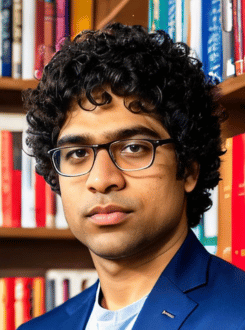Tutela’s PSAT Preparation Program is designed to help students master the skills tested in the PSAT/NMSQT, PSAT 10, and PSAT 9, ensuring a confident start to their SAT journey. Our curriculum mirrors the official College Board structure, focusing on Reading & Writing, Math, and test strategy while providing the personalized guidance Tutela is known for.
Specialized in one-on-one personalized sessions led by expert PSAT tutors with years of proven success.
Covers PSAT-specific topics in Reading and Writing and Math sections with rigorous testing cycles for score improvement.
Exclusive access to 50,000+ practice questions across courses based on official past PSAT resources.
Students and Parents receive real-time updates through Tutela Connect and dedicated groups with Academic Heads and Teachers to ensure the right resolution to queries.
| Feature | Tutela’s PSAT Program | Other PSAT Programs |
|---|---|---|
| Class Size | Individual Private Classes with focused attention | 15–30 students, diluted attention |
| Faculty | Experts with 90%+ success in improving scores | Freelancers / college students |
| Approach | Customized learning plans for strengths & gaps | One-size-fits-all syllabus |
| Course Flexibility | Fully adaptable to pace & needs | Rigid lesson plans |
| Technology | AI-powered diagnostics, progress maps, analytics | Basic score reports |
| Parent Involvement | Transparent reports & strategy calls | Minimal or no updates |
| Global Reach | Students from 20+ countries | Limited local presence |




Adithyan Diwakar
SAT: 1600 / 1600

Aarav Goel
SAT: 1600 / 1600
AP Physics C: Mechanics: 5 / 5
AP Computer Science A: 5 / 5

Pranet Khetan
SAT: 1600 / 1600
AP Calculus BC: 5 / 5
AP Computer Science A: 5 / 5

Romir Kumar
SAT: 1600 / 1600
AP Calculus BC: 5 / 5

Aksh Agarwal
SAT: 1590 / 1600

Kriti Bhabu
ACT: 36 / 36

Ria Chopra
Physics HL: 7 / 7

Ananya Bansal
AP Calculus BC: 5 / 5
AP Chemistry: 5 / 5
AP Microeconomics: 5 / 5
AP Physics C: Mechanics: 5 / 5

Nischay Singh
AP Calculus BC: 5 / 5
AP Macroeconomics : 5 / 5
AP Microeconomics: 5 / 5
AP Physics C: Mechanics: 5 / 5
AP Statistics: 5 / 5

Akrit Agarwal
AP Statistics: 5 / 5
AP Calculus BC: 5 / 5
ACT: 36 / 36
Tutela’s PSAT prep is designed by expert mentors who understand the College Board’s testing framework. We focus on conceptual clarity, adaptive practice, and test-taking strategy. With our various class formats, every student receives personalised attention and detailed performance analysis through our Tutela Connect portal.
Yes. The PSAT is part of the SAT Suite of Assessments, so both tests share the same question types, skills, and scoring structure. Tutela’s PSAT program is strategically aligned with SAT prep, helping students build the foundation they need for a higher SAT score later.
All assessments, assignments, and full-length tests are tracked through Tutela Connect, our digital learning and reporting system. Parents and students can view progress reports, performance trends, and detailed test analytics after every evaluation.
At Tutela, we want students and parents to feel completely confident when starting their learning journey with us. That’s why we offer a 14-day, no-questions-asked refund policy.
If at any point during the first 14 days you feel the classes are not the right fit, you can request a refund. Our goal is to ensure both parents and students feel comfortable, supported, and satisfied with their decision to learn with Tutela.
Turning journeys into stories that inspire us every day
Tutela has been an amazing experience with helpful and patient teachers. Even in the situation of Covid-19, they were able to provide so many resources and classes to me, and were always ready to address my concerns and help me improve. Appreciate all their help :) Read More

Pathways School, Aravali, Haryana, India
Tutela helped me score close to perfect in every exam they’ve coached me in. Ashish sir, Mukul sir, Anam Ma’am, Prashansa Ma’am, and Somendra Sir has a brilliant teaching style which helped me not only understand but also gain interest in the subject. Read More

The Shri Ram School, Aravali, Haryana, India
Tutela has the most helpful, approachable, and resourceful teachers! There're wonderfully talented at their respective subjects and great at calming down all pre-exam stresses. I would highly recommend it to all standardized test-takers. Even during the lockdown, all classes were really effective! Read More

The Shri Ram School, Aravali, Haryana, India
My experience with Tutela has been amazing! Tutela was beneficial for the SAT by always sending me extra reading sections, which was my weak point. Tutela made sure that I felt comfortable with all topics on the SAT. The test and review were very efficient in eradicating silly mistakes, with detailed doubt clearing sessions to follow. I gave 4 APs with Tutela, 2 entirely from scratch. They ensured I knew all the content, and they were available at all times to clear doubts. On the day before the exam, I had daily revision sessions, which were really helpful. I would definitely recommend Tutela to anyone giving standardized tests, especially the test and review! Read More

The Shri Ram School, Aravali, Haryana, India
Tutela is the best place to prepare for AP’s as well as standardised tests. Their exceptional faculty along with their thorough study plans ensure results. While practicing for my SAT with Tutela, I came across some questions which were asked verbatim on the actual SAT! Read More

The Shri Ram School, Aravali, Haryana, India
Tutela has been one of the most integral parts of my college applications process. As soon as I joined Tutela, I was overwhelmed by how supportive the teachers were. They helped me improve my SAT score by 120 points and they also helped me a get a 800 in SAT Subject Test(Math). I also took AP Calculus and Statistics classes, in which I got 5 and 4 respectively. Most importantly, teachers and students at Tutela share a mentor-mentee relationship which makes the learning experience thoroughly enjoyable. I strongly recommend Tutela as the one stop destination for standardized testing and APs! Read More

Sanskriti School, Gurgaon, Haryana, India
Since I have a joined Tutela, I have been very happy with it. The faculty is very supportive. No matter how much I messed up, they never gave-up and believed in me. Read More

The Shri Ram School, Aravali, Haryana, India
My experience at Tutela has been a wonderful one! They helped me improve my ACT score by 11 points! They are very flexible, you can come in and give a practice test anytime you want. They are kind, friendly, and helpful. They truly care for their students. They are there for you every step of the way, even the stressful days. I feel very lucky that I got to meet such supportive, and caring people! Read More

Unkown
Tutela is an extremely organized center and provides students with ample resources to achieve the scores they desire. The helpful and patient teachers along with the multiple practice tests helped me obtain a 35 on the ACT, along with great SAT subject test and AP scores. Overall, it is a great center, and I would highly recommend it to anyone. Read More

Metro Delhi International School, Greater Noida, India
Tutela has been such a great help! They are really thorough and provide materials that are unparalleled. The teachers are so amazing! Been a great journey. Read More

Dhirubhai Ambani International School, Mumbai, India
The environment at Tutela is very conducive to learning. I also had personal connections with my teachers who consistently motivated me towards increasing my scores. I also think the practice tests were very important as it helped my score 36. Read More

Pathways School, Aravali, Haryana, India
Tutela really personalised my test review which i didn't find anywhere else. The realistic yet challenging practice tests helped boost up my score significantly. Reviewing the answers i got wrong one on one prevented me from making similar mistakes in the future. Read More

American Embassy School, New Delhi, India
